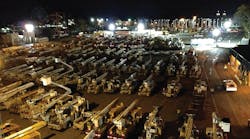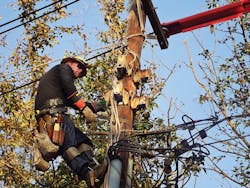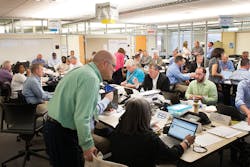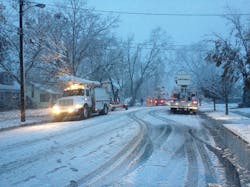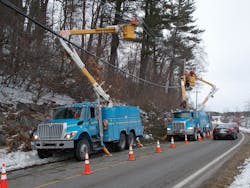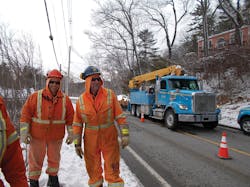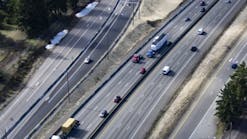Roaring winds, extreme temperatures and heavy rainfall are no match for today’s linemen. When severe weather hits, they lace up their boots, slip on their workwear, don their hard hat and get to work — not only for their utilities but also for neighboring utilities.
“Restoring power to customers after a storm is complex and must be completed as safely and quickly as possible,” said Nelson Yip, director of emergency management for Consolidated Edison of New York, which provided mutual assistance to Dominion Energy after Hurricane Matthew and sent crews to Rochester, New York, after a major windstorm. “Electric companies have a long tradition of helping each other with restoration. Our mutual assistance philosophy is that it’s better to give than to receive. Mutual assistance is about relationships and helping our peers when they are in need and we are not affected by severe weather. It’s also critical to restoring power and meeting our customers’ needs following storms.”
For more than a century, utilities have helped one another in their time of need, says Michael Hyland, senior vice president of engineering services for the American Public Power Association (APPA). The association, which serves as a link between public power utilities and the federal government, coordinates the overall national movement of member utility crews through its mutual aid program.
“The use of mutual aid is the lifeblood of utilities heading into and after storms,” said Hyland, who has been working in the power industry for the last 30 years. “These storms can range from Superstorm Sandy to snow drops, mud slides, ice storms and tornadoes.”
In the past, the mutual assistance programs were not standardized, and they were akin to “calling your neighbor and asking for a cup of sugar,” Hyland noted.
However, following Hurricane Katrina and Superstorm Sandy, the power industry — including investor-owned utilities (IOUs), municipalities and cooperatives — began exploring how to enhance mutual assistance.
“After Sandy, the industry did a nice job of pulling together resources from around the country,” said Hyland, who worked for Philadelphia Electric Co. and Public Service of New Hampshire, and also served as the chair of the National Electrical Safety Code. “President Obama was up for reelection, and the White House, for the first time, really got involved in ensuring that the federal government opened its arms to provide help to assist in the restoration of electric and gas and water to the consumers hit in New Jersey, Connecticut, New York, Ohio and New Jersey.”
For a post-incident review, called a “hot wash,” in May 2013, Obama brought in CEOs from utilities as well as representatives from trade associations, labor unions, the American Red Cross and many federal agencies. He then conducted a thorough review of the disaster response and how to improve storm restoration going forward.
“He told the industry that we did a great job but that we could do better,” Hyland recalled. “We agreed that the marching order was to find ways to improve restoration for our customers.”
The following 10 strategies can help utilities to get the most out of mutual aid — whether they are responding to a severe storm or requesting assistance.
1. Connect with Neighboring Utilities and Contractors
On the state and regional level, electric utilities can participate in a variety of different mutual aid groups. On the national level, however, the three key programs include the Edison Electric Institute (EEI) voluntary mutual assistance program for mostly IOUs, the public power mutual aid program operated by APPA and the Federal Emergency Management Agency (FEMA)-based regions for cooperatives.
EEI’s mutual assistance program is based on voluntary agreements among IOUs within the same region. Most of these agreements are managed by seven regional mutual assistance groups (RMAGs) nationwide, and they regularly communicate and help one another when disaster strikes.
When a utility needs to bring in mutual assistance, it makes a request through the regional group, which determines the personnel and equipment needs in each region. In the Northeast, a utility would reach out to the North Atlantic Mutual Assistance Group (NAMAG) or supplement resources, and its pool of restoration crews and emergency contractors.
Essentially, utilities participate voluntarily in the agreements with others in their region, and when one needs mutual assistance, it makes the request through the regional group, Con Edison’s Yip says.
“In cases where we are providing assistance, we canvass our people for volunteers,” Yip said. “We want to get crews on the road and ready to work by the time the host utility needs them.”
Since Superstorm Sandy, the mutual assistance response and restoration process has been enhanced. The traditionally smaller RMAGs in the Northeast learned they overlapped in terms of service territories and participating utilities. In 2013, these three RMAGs — New England, New York and Mid-Atlantic — consolidated to form NAMAG, a voluntary association of 25 utilities with more than 36 million customers. Yip says this enables a more efficient mutual assistance process and a larger pool of resources on which to draw.
“The three RMAGs got together to create a super RMAG in their region, which is larger in geographic scope and scale,” said Chris Eisenbrey, senior director of business continuity and operations for EEI. “We then created the National Response Event (NRE) framework, which we exercise on a regular basis.”
2. Practice Storm Response
On a national level, EEI’s utility members formalized a system or framework to coordinate the industry’s mutual assistance process to allocate industry resources in the most efficient and effective way possible. The NRE builds on the foundation of the RMAGs but provides the ability to scale the system up to a national level. The CEO or designee of an affected utility can declare a NRE, which is reserved for the most significant events, such as when many RMAGs may not be able to provide support because of resource constraints.
To test its response to a NRE, since 2013, EEI has organized nine different drills covering hurricanes, derechos, earthquakes and ice storms. Most recently, the storm-response exercise, which was run by EEI and hosted by NV Energy in Las Vegas, Nevada, simulated an ice storm in the Midwest quickly followed by an earthquake in the Pacific Northwest. As such, the utilities, EEI team and government officials had to determine the best way to allocate and then reallocate resources during simultaneous events.
Every year, EEI sponsors two different storm drills, one in early spring and the second close to the start of the hurricane season on June 1. The spring drill is organized as a tabletop exercise, in which the utility executives verbally run through the process, discuss problems and identify issues that need further improvement. During the summer drill, however, the participants do not just talk about storm response, they practice it step by step, by allocating resources and connecting with government officials. They also follow EEI’s NRE playbook.
“Our playbook is a living document that lays out the different processes and protocols so we can be prepared and have our ducks in a row. So if a National Response Event occurs, we are ready to hit the ground running,” Eisenbrey said.
Because a national storm response requires engagement from government associations such as the U.S. Department of Energy, Department of Defense, Department of Homeland Security and FEMA, EEI has run some of its tabletop exercises with these agencies in attendance out of its headquarters in Washington, D.C.
However, because D.C. may be in the bullseye of a storm, EEI also has designated seven other alternative sites around the country, including northern Virginia; Dallas; Portland, Oregon; San Francisco; Chicago; and Las Vegas.
3. Manage Crew Allocation Online
Following Superstorm Sandy, EEI’s utility members and association executives engaged with the local, state and federal governments to determine how to improve future storm response. One area with room for improvement was the allocation of crews. At that time, the utilities connected by conference calls and tracked resources on spreadsheets.
“We used to do it with pen and paper, and it was an outdated and cumbersome process,” Eisenbrey said. “Each utility had to walk through a conversation to see how many resources they had on hand and how many were needed. We determined that, after Sandy, when our industry was in the spotlight, it was a great time to make an investment in a more standardized, scalable tool.”
Today, the leaders of each RMAG can create a storm event online in a resource allocation management program for utility personnel (RAMP UP) application. Electric utilities and contractors not impacted by the storm can input what resources they are able to supply; through an algorithm, the tool matches the requesting utility with neighboring resources. In addition, the RMAGs can secure assistance from vendors, restoration crews and contractors.
“The RMAGs use the tool for regional and national storms, so when help is needed, they already know how to use it and much of the information is already pre-populated,” Eisenbrey said.
4. Understand What You Are Getting Into
Following a severe weather event, responding utilities should get details about the requirements to share with their linemen before they depart, Hyland says.
“You need to sit back and make sure that you have your ducks in a row before you send crews out into a storm,” Hyland noted. “You need to not only know what the conditions are now but also what could happen in the near term.”
Case in point: Superstorm Sandy hit during Halloween week. Less than a week later, a snowstorm blasted Maryland, surprising some mutual assistance crews.
“When the crews first came to Maryland, there was a beautiful sky, and then came three to six inches of snow,” Hyland recalled. “The conditions were much different than when they left home, and a lot of crews didn’t have the right clothing, equipment or personnel.”
One of the most pressing issues facing responding utilities is whether to send all their crews into the storm to hunker down, or bring them halfway and hold them near the strike zone. For example, when Superstorm Sandy came up the Carolina coast, it hit Maryland and Delaware, and then went north, hitting New Jersey and New York.
“Is it better to pay crews to sit in a location where they’re not needed, or is it better to hold tight and then, if you do get hit, call for help?” Hyland asked. “I think it’s a 50-50, and it’s like reading a tea leaf.”
Yip says electric utility industry professionals are like farmers in that they watch the weather carefully.
“We usually know days in advance that a major storm is coming, and begin lining up mutual assistance and contractor employees,” Yip said.
5. Send the Right Crews
A speedy restoration requires logistical expertise, skilled workers and specialized equipment, Yip says. To ensure the right resources are sent for storm restoration, Yip says Con Edison’s emergency management group uses a checklist to mobilize crews quickly — or receive them on the requesting side of mutual assistance.
Following Superstorm Sandy, however, Hyland says some utilities learned they did not send the right resources. For example, one utility sent overhead transmission crews to provide mutual aid in areas with underground distribution. While these crews ended up being sent home, another utility based in Los Angeles reviewed a schematic of the underground system before they even started working.
“When the crews got off the plane at the military base, they had already reviewed the specs and were familiar with them,” Hyland explained.
Along with sending the proper crews, it often is beneficial to deploy support personnel, as well. Rather than sending just 20 linemen and 20 bucket trucks on the road, some utilities also are sending managers and a mechanic to fix trucks if they break down by the side of the road.
In addition, some utilities will send a scout to find out where the crews are working, how they will be fed, where they can fuel their trucks, where they will be sleeping and whether they will be paid the proper rate for their work.
“As the guys are traveling across the country, the scout can ensure that everything is set up,” Hyland said.
6. Secure Lodging for Linemen
When a responding utility gets a request for mutual assistance, the utility must understand how long its linemen will be needed and also whether they have sleeping quarters — before they arrive.
“After Sandy, some crews got into hotel rooms while others slept in FEMA trailers or in their own trucks, or on cots in fire halls and police stations,” Hyland recalled. “Try to adapt, overcome and be flexible. Understand that not everything will go perfectly during a disaster.”
While Hyland says the electric power industry has done a good job of responding to storm-related outages over the last 100 years, the customer experience and expectations have changed significantly. For example, 50 years ago, utility customers did not rely on cell phones, laptops and other mobile devices.
With that in mind, electric utilities continually are striving to improve on mutual aid and storm response programs. Nearly every utility tests its disaster response plan annually and, during this exercise, a utility must not only make sure it has enough hotel rooms for mutual aid crews but also enough gas stations and food for the linemen. Logistically, utilities face many challenges and questions to answer whether they are requesting or responding to mutual assistance calls.
“When linemen show up in the hundreds by your door, where are you going to put them?” Hyland asked. “Where will they sleep? What will you feed them? Who will watch them from a safety point of view? How many days will it take to get there?”
For the restoration following Hurricane Sandy, Con Edison brought in 5500 mutual assistance and contractor workers, both overhead and underground, from as far away as California and Canada, says Carlos Torres, vice president of emergency management for Con Edison.
“With their help, we were able to restore 1.1 million customer outages caused by Sandy and a nor’easter that hit the following week. This was our largest-ever mutual assistance effort. We set up base camps for the workers to sleep, eat and rest while they were off duty.”
7. Communicate with Crews and Customers
On most job sites, linemen easily can touch base with smartphones, laptops and tablets. When they drive into a storm-stricken territory, however, all bets are off when it comes to the quality and availability of communication.
For example, after Superstorm Sandy, all the communication networks were down, and the linemen could not rely on their cell phones. To stay in touch, some crews set up a regional network or relied on walkie talkies. Others took a different approach by assigning a bird dog, but this can be exhausting from the responding utility’s perspective, Hyland says.
“You can assign one engineer or someone who isn’t directly involved in the restoration to each crew, to run the circuit and make sure the linemen are fed and taken care of,” Hyland said. “This person will be assigned a radio and be able to be in constant communication.”
In addition to crews communicating with one another, utilities also must find a way to deliver storm updates to the customers in the service territory before, during and after severe weather events. For Superstorm Sandy, utilities used text messages, emails and robocalls to help areas that might be impacted by the hurricane to prepare for it.
At Con Edison, the damage assessors record information on tablets. In addition, the utility has a device-agnostic damage assessment mobile application for employees, contractors and mutual assistance resources to use.
“This allows for a much more efficient and organized gathering and reporting of information than the old pen-and-paper method,” Yip explained.
As part of its outage management system, the utility came up with a dashboard for municipal officials in Westchester County. With this technology, officials can view the outage status in their city, town or village; get estimated outage times; and report outages.
When possible, some electric utilities also are using advanced mobile technology in the field, which is enriched by smart meter technology. While line workers used to have to drive through a neighborhood to look for outages, smart meter technology can pinpoint clusters of outages and identify where utilities should deploy crews.
“A lot of our members are taking their IT to more mobile devices, so the line workers and crew chiefs that helped to deploy the line workers out in the field have that information at their fingertips,” Eisenbrey said. “Through smart meters and the smart grid, we can find out where the outages are located and then deploy or redeploy resources.”
8. Help Crews to Get to the Restoration Zone Swiftly and Safely
At many utilities nationwide, the culture has changed, Hyland said. Today, the focus is more on safety than speed.
“It used to be that utilities would hurry up and get there as fast as they could, because they wanted to get involved and start working,” Hyland said. “Today, the focus is more on trying to get there as fast as you can — safely.”
Utilities must ensure linemen are well rested before they travel or start working.
“We don’t want the guys to get in the truck and drive another 10 hours to get to three towns over,” Hyland said. “We’d rather have them go home, get eight hours of sleep and start in the morning. We need to understand that driving is working, and we need to make sure they are switching drivers and obeying the speed limit. We want them to get there safely, work safely and return home safely.”
In the 1980s, bird dogs had to rely on paper maps to mark circuits with cones on the side of the road. Today, many bucket trucks are equipped with laptops and smartphones with GPS capabilities. Utilities can keep tabs on their crews through fleet management software; they easily can calculate how many hours the truck has been on the road and whether linemen have gone to the hotel to sleep and the restaurant to eat.
“It used to be very manual, but now monitoring crews is easier and better,” Hyland observed.
In addition, EEI also is working on ways to make it easier for restoration crews to cross state lines and country borders. For example, in the Northeast, the contractor and vendors use the E-ZPass system. During Superstorm Sandy, however, a lot of the outside electric utility crews, vendors and contractors were held up at the tollbooth because they typically worked outside the E-ZPass system.
“We have spent the last five years trying to smooth this out for our electric companies so they can get from one region into another easily during storms,” Eisenbrey said.
9. Invest in Technology
Over the years, electric utilities have invested in new tools and technology to improve the productivity and safety of their field workforce. For example, vendors offer voltage detection devices to keep crews safe when working near downed power lines.
In addition, some utilities rely on helicopters with video technology to fly over a storm-stricken zone, take photos and videos, and then send this information back to the utility. In the future, Hyland says drones could assist utilities with overhead line inspections, but because of line-of-sight issues, linemen often are limited in where they can use the unmanned aerial vehicles.
Currently, Con Edison has benchmarked with other utilities and is using drone technology in applications allowed by the law. The utility also is working with industry groups and developers to advance visualization technologies for distribution damage assessment and analytics.
“If we believe it will help us with storm restoration, we’ll certainly consider all options,” Yip noted.
During Hurricane Matthew, drones proved to be a very powerful tool to support faster and safer damage assessment in Florida and the Carolinas, Eisenbrey says. In fact, EEI’s member utilities approached the U.S. Federal Aviation Administration to obtain temporary waivers or permits to fly over the flood-stricken areas.
“After the wind died down, they were able to deploy these unmanned aerial vehicles to do damage assessments,” Eisenbrey said. “Due to widespread flooding, we couldn’t get into the areas that were flooded; you can’t drive a truck through standing water or you will be swept away. We deployed the drones to give us a bird’s-eye view of the flooding and damage.”
Going forward, he says EEI wants to push the envelope in a safe manner when it comes to drones.
“We are trying to get beyond the visual line-of-sight usage or permits,” Eisenbrey said. “If we didn’t have to do that, we could send a drone far away to monitor and gather data through video or LiDAR. Once we can go beyond the visual line of sight, it will be a game changer once we can do that in a safe and legal manner.”
Currently, many utilities are relying on helicopters for damage assessments, but Eisenbrey says drones can offer a safer and more economical alternative.
“Helicopters are more expensive and time consuming than a drone,” he explained. “The other issue is safety. Helicopters are manned by people, and they crash. With a drone, you are not connected to the vehicle, and you are apart from it.”
10. Put Safety First
The host utility often invites mutual aid crews to its safety meetings to make them aware of known dangers in the storm-stricken zone. Requesting utilities only allow outside mutual aid crews to work dead-on tasks such as rebuilding poles and transformers. They then turn to their own internal crews to reenergize the circuit. In some cases, however, mutual aid crews may be able to work live lines if they have the right equipment, trained personnel and a bird dog watching them, Hyland says.
In general, linemen have fewer accidents during mutual aid projects than any other time, according to Hyland.
“Linemen are locked and loaded, and focused on the job during mutual aid,” he explained. “They know the dangers and, because they are outside of their territory, they are not complacent. In fact, more injuries can happen on the road getting to the mutual aid site than during the work itself.”
In Con Edison’s experience, the most important safety principles apply across the board. For example, at Con Edison, each job — whether it involves mutual assistance and contractor employees, or only Con Edison employees — begins with a safety job briefing and a review of human performance improvement principles. The briefing addresses details of the work that is about to take place as well as any potential hazards. During this meeting, questions and situational awareness are encouraged.
“Workers must wear the proper protective clothing, set up equipment and safety barriers correctly, and cross-check their colleagues to make sure they are working properly,” Yip said. “These and other safety principles are consistent across the country.” ♦
Sidebar: Crossing the Canadian Border to Provide Mutual Assistance
Winter Storm Stella blasted New York, Pennsylvania and Vermont with 3 ft to 5 ft of snow in mid-March 2017. Because of the amount of snowfall in the Northeast and hurricane-force wind gusts in New England, the storm was rated as a Category 3 by the National Centers for Environmental Information.
Almost 250,000 customers from Virginia to Pennsylvania were without power because of the severe storm. To help restore power quickly, Quanta Services and National Grid called on Valard Québec for assistance. Oftentimes, the snowstorms in the Northeast also hit the Québec province, but that was not the case with Storm Stella. As such, Alain Gagné, vice president of Valard Québec, says he had enough manpower available to lend a helping hand.
“Most of the time when the Northeast is hit with a storm, our regular clients prefer to keep us close to home, but this time, we had the manpower, equipment and availability to help out,” Gagné said.
Gagné says he worked with National Grid to firm up plans for assistance, and then he began ramping up crews, mobilizing linemen, and lining up tools and equipment. Because Valard Québec was helping a utility not in Canada but across the border, one of the first priorities was securing the proper paperwork.
Valard Québec had to supply the names of the linemen as well as their citizenship, driver’s license and passport numbers to National Grid. The stateside utility then was responsible for sending these forms to U.S. Customs and Border Protection. In turn, National Grid had to submit a letter to Valard Québec requesting its assistance.
“If we are called to help out with a storm, we can’t just go across the border,” Gagné explained. “Instead, we must have a letter from the public utility stating that they need our service to help restore power, so we can go.”
On March 13, 2017, Valard Québec sent 14 two-man crews with support on an eight-hour road trip to help National Grid. When the linemen arrived on-site, they received training on safety and the working conditions during restoration.
“The most important thing when we go into a storm like that is what precautions we need to take to make sure nothing bad will happen,” Gagné said. “National Grid told us how to proceed and where to go to restore power. They also provided our crews with lodging and meals. They are very well organized when it comes to storm restoration.”
The linemen worked 16-hour shifts for four days in the Northeast to help restore power following the snowstorm.
“Conductor wire fell from the poles, crossarms were broken and trees fell on top of the lines,” Gagné said. “Most of the outages were caused by branches and trees due to the load of the snow and the wind.”
As in any severe weather event, the Valard Québec crews faced challenges. For example, the crews had to work at night and in heavy snow, which limited visibility and increased traffic control concerns. Because of the downed lines from the storm, crews also had to ensure the lines were de-energized before they began restoring power. Finally, some of the linemen faced a language barrier. About 95% of the population of Québec speaks French as a first or second language, and as such, Valard Québec made sure to send a few of its linemen who were proficient in English to communicate with National Grid.
Despite the challenges linemen faced during the restoration, Gagné says the Valard Québec crews were prepared to handle anything that came their way.
“Our trucks were well equipped with the tools to perform the work, and we sent experienced lead and journeymen linemen to help out with the restoration.”
Gagné says the linemen enjoyed being able to restore power in the Northeast.
“People are very happy to see us when we work there, and the residents are always very welcoming,” Gagné noted.
Sidebar: Linemen Share Field-Proven Best Practices for Storm Restoration
Don Sherman, a lineman for 30 years at Midwest Energy in Great Bend, Kansas, and a field service representative, as well as Rick Roby, a lineman for Rocky Mountain Power and a flame-retardant (FR) clothing distributor, share their tips and techniques for working in severe weather conditions — and living to tell about it.
Dress in layers. When restoring power following a storm, it is essential to stay warm and keep dry, Sherman says. For that reason, he advises that linemen wear different layers, such as thermal underwear underneath FR jeans or a FR shirt underneath FR outerwear. He says many of the younger linemen learn how to dress appropriately from their outdoor hobbies, such as fishing and hunting, and as such, they are prepared when it comes to line work. However, in Kansas, where the weather is very unpredictable, it can be a challenge.
“Kansas is one of the worst states because you have to work in 100°F and below zero,” said Sherman, who has been working in the utility industry for 42 years. “It is a tough state to work in.”
Wear a moisture-wicking jacket with a water-repellent finish. When most linemen go out to work in the rain, they often wear polyvinyl FR rainwear.
“It does not breathe, and it’s like wearing a garbage sack,” Roby said.
In addition, the new FR GORE-TEX rainwear on the market can run about $1000 each, but, Roby says, Dragon Fur has a Shield jacket suitable for working in light rain or snow.
Invest in the right FR clothing. In Salt Lake City, Utah, Roby says he and the other linemen work in weather extremes from the frigid cold to more than 100°F for weeks on end. In these types of high desert conditions, he recommends lightweight performance FR clothing, which is a significant improvement from the first FR garments that came on the market, he says.
“I’m used to the old style of FR clothing, which couldn’t move much,” Roby said. “It was like wearing a burlap sack.”
Choose light-colored shirts. Linemen who work in a hot, sunny climate should wear a FR shirt that is light in color, is lightweight and offers arc protection to avoid heat stress hazards, Roby says.
“You don’t want to wear a dark navy-blue FR shirt in 100°F heat,” Roby noted. “A high-[visibility] yellow reflects the sun’s rays better than anything.”
Stay away from cotton. Oftentimes, cotton will just absorb moisture, and does not wick and let a garment dry, Roby says. For that reason, he often wears fleece beanies, gloves and wool socks.
Do not skimp on footwear. Linemen may need to make a significant investment in a high-quality boot, but it is worth it, Roby says. For example, he wears Italian-made work boots that cost about $400. He also says Kenetrek has a new lineman’s boot with a carbon-based hard toe.
Stock overboots in the truck. Linemen should bring good boots with them along with overboots, which can protect their feet before they become wet, Sherman says.
Purchase clothing that will stand the test of time. Linemen work out in severe conditions to restore power following storms, and they need garments that will last from one storm to the next. For example, the Exxtreme jacket from Dragon Fur features Nomex ripstop fabric on high-wear areas such as the shoulders, arms and elbows. Also, the vendor offers a lifetime warranty on their products.
“I ran into an operations manager who had one of the first Dragon Fur fleece jackets,” Roby said. “He told me that the jacket is five or six years old, and he broke the zipper within the first year of owning it. He sent it to Dragon Fur, and they replaced it.”
Stay hydrated. When working in high heat and humidity, linemen must take breaks and drink plenty of water, Sherman says.
Put on waterproof thermal gloves. During a storm restoration, linemen may be dragging wires out of water, and they need to ensure they have the proper pair of gloves. Also, the gloves should be loose fitting and not very tight, Sherman adds.
Look out for one’s own welfare. “The older and wiser I get, I have learned that you need to take care of yourself,” Sherman said. “That way, you can be out there for the long haul.”
Read the complete Linemen supplement in the September 2017 issue.
